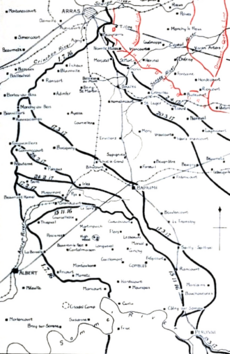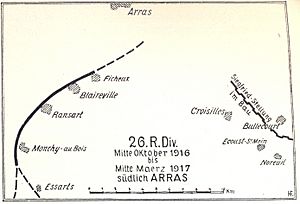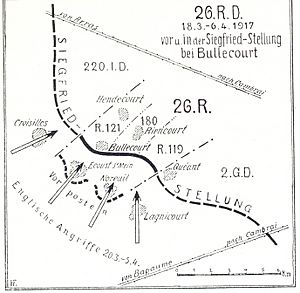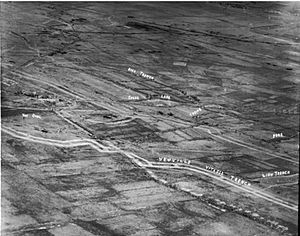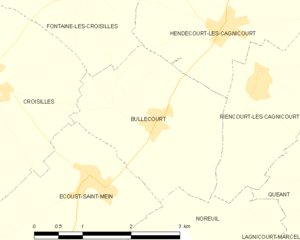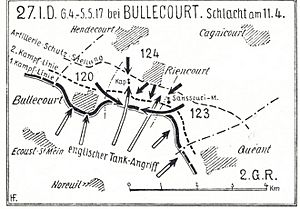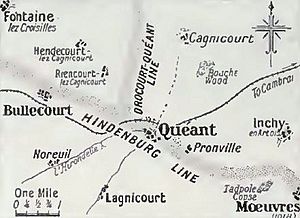First attack on Bullecourt facts for kids
Quick facts for kids First attack on Bullecourt |
|||||||
|---|---|---|---|---|---|---|---|
| Part of Flanking Operations to the Arras Offensive; Round Bullecourt (11 April – 16 June) Western Front, First World War | |||||||
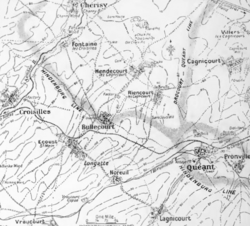 Relief map showing the Hindenburg Line and Wotan Line (Siegfriedstellung, Wotanstellung) defences around Bullecourt and Quéant, 1917 |
|||||||
|
|||||||
| Belligerents | |||||||
| Commanders and leaders | |||||||
| Douglas Haig Hubert Gough |
Paul von Hindenburg Crown Prince Rupprecht |
||||||
| Strength | |||||||
| 1 division | 1 division | ||||||
| Casualties and losses | |||||||
| 10 April: 162 11 April: 3,289 (1,166 PoW) |
11 April: 749 | ||||||
The first attack on Bullecourt happened on 11 April 1917 during World War I. It was a battle on the Western Front in France. Soldiers from Australia and Britain, part of the British Fifth Army, attacked to help another British army fighting nearby. This larger battle was called the Battle of Arras.
The plan was for twelve tanks to lead the attack. They would smash through the German barbed wire. This would clear a path for the soldiers to enter the strong German defenses, known as the Hindenburg Line. But the tanks were late. Because of this, the attack by the 4th Australian Division was put off.
However, another British group, the 62nd (2nd West Riding) Division, did not get the message. Their patrols went ahead into the Bullecourt defenses. They faced heavy fire and lost 162 soldiers before returning. This event became known as the "Buckshee Battle."
The next day, the attack on Bullecourt went ahead. Many tanks broke down or went off course. Even so, both Australian brigades managed to get into the German front lines. But they were cut off and slowly defeated. Only a few Australians were able to escape. The Australians suffered 3,289 casualties, including 1,166 prisoners. The German side had 749 casualties.
After the battle, the Australian commanders apologized to their surviving soldiers. The Germans who led the defense received special awards. The Australian soldiers felt bitter and did not trust tanks or General Hubert Gough, their army commander, for a long time.
Contents
Why the Battle Happened
The Hindenburg Line: Germany's Strong Defense
In 1916, Germany changed its top military leaders. Paul von Hindenburg and Erich Ludendorff took charge. They decided to build a new, shorter defense line on the Western Front. This line was called the Siegfriedstellung, also known as the Hindenburg Line.
This new line was meant to save soldiers and create more reserves. It stretched from Neuville-Vitasse near Arras to Laon. The Hindenburg Line was a very strong defense. It had deep trenches and concrete shelters. It was built to stop attacks from the British and French armies.
Operation Alberich: German Retreat
In early 1917, the German army began a planned retreat to the Hindenburg Line. This was called Alberich Bewegung (Alberich Manoeuvre). They pulled back from a long section of their old front line. As they left, they destroyed roads, bridges, and villages. This made it very hard for the British to follow them.
The Germans wanted to make sure the British could not easily attack them. They also wanted to finish building the Hindenburg Line. Some villages close to the new line had to be held longer than planned. This was to allow more defenses to be built.
German Defenders: XIV Reserve Corps
By 1917, German army groups were organized differently. The XIV Reserve Corps (called Gruppe Quéant) was in charge of the Hindenburg Line around Bullecourt. This area was defended by the 27th (Württemberg) Division.
The soldiers of the 27th Division were not impressed with their new positions. The trenches and wire did not have deep dugouts or strong shelters. The Hindenburg Line here was on a slope, so the German soldiers in the front lines could not see far. They had to set up observation posts and send out patrols to watch for the British.
Getting Ready for Battle
British Fifth Army's Plan
The British Fifth Army was supposed to help another British army in a different attack. But the German retreat to the Hindenburg Line changed everything. Now, the Fifth Army had to attack the strong Hindenburg Line itself. This was a much harder job.
The Fifth Army had fewer soldiers and less artillery. Moving their remaining guns and ammunition was slow because the Germans had destroyed so many roads. The Hindenburg Line was much stronger than the old German defenses.
General Gough, the Fifth Army commander, decided to attack Bullecourt. This village was a key point in the German line. If the Fifth Army could break through here, it would help the other British army.
The plan was for the 4th Australian Division and the 62nd (2nd West Riding) Division to attack. They would attack on a wide front with Bullecourt in the middle. The village of Riencourt was the second goal, and Hendecourt the third. British tanks were also brought in to help.
Final Preparations: April 8–9
The Hindenburg Line around Bullecourt was very strong. It was defended by the elite German 27th (Württemberg) Division. On April 8, it was clear that cutting the German wire would take more time.
On April 9, the Third Army began its attack at Arras and had great success. A tank commander suggested that all the tanks should attack together. They would create one big gap in the wire instead of many small ones. General Gough agreed. He ordered the tanks to attack on April 10, between Bullecourt and Quéant. This left no time for practice with the Australian soldiers.
The tanks were supposed to go first and crush the wire. Once the Hindenburg Line was captured, some tanks would turn towards Bullecourt. The 62nd Division would then advance. Other tanks and Australian soldiers would capture Riencourt.
Patrols went out at dusk and found that the Hindenburg Line was still held by Germans. However, the shelling had made some lanes through the wire. The 4th Australian Division would attack with two brigades. A gap was left between the brigades to avoid a dangerous area. The attack was set for 4:30 a.m., before sunrise, to avoid heavy German fire.
The "Buckshee Battle": April 10
At 1:00 a.m., Bullecourt was hit with gas shells. Australian soldiers waited in the snow of no man's land for the tanks. Six battalions were out in the open. Dawn was getting close. The attack was delayed because the tanks were still two miles away. They were moving slowly through a snowstorm.
The Australian commander, Major-General Holmes, postponed the attack. He wanted to get his soldiers back to safety before they were seen. Snow started falling again, which helped hide their retreat.
However, the 62nd (2nd West Riding) Division did not get the message until 4:55 a.m. Their patrols had already started advancing at 4:35 a.m. They got through the barbed wire in ten minutes. At 4:50 a.m., German machine guns opened fire. By 5:10 a.m., the British patrols began to retreat. They left two machine gun crews behind. These patrols suffered 162 casualties before they returned.
The German commander, Maur, knew an attack was coming. But he could not get many reinforcements because of the fighting at Arras. During the night of April 10/11, German listening posts heard engine noises. They thought it was supply trucks. But at 3:45 a.m., the engine noise grew louder. This showed that a tank attack was beginning.
The Main Attack: April 11
British Tanks Advance
After the delay, the attack was set to resume on April 11. General Birdwood still had doubts about attacking. But the British headquarters decided the attack was needed to support the main battle at Arras.
Some changes were made to the plan. The infantry would now advance fifteen minutes after the tanks. This was because the wire-cutting had gone better than expected. Only four of the eleven tanks reached their starting line by 4:30 a.m. The Germans could hear their engines.
The tanks faced many problems. One tank went off course and had mechanical issues. Another tank also veered right and was knocked out by German machine guns. The next tank got stuck in wire and was also destroyed. The last tank started late and followed a similar path.
The tanks on the left side were also late. Two were knocked out before reaching the German trenches. A third tank arrived after the Australians were already in the German lines. It silenced a machine gun in Bullecourt but was hit twice. The last tank got stuck. By 6:30 a.m., most tanks were destroyed by German artillery.
Australian Soldiers Attack
German artillery started shelling the Australian assembly areas at 4:23 a.m. Flares went up from Bullecourt. The Australian soldiers tried to advance but suffered many casualties. The tanks arrived one by one, which reduced their impact.
As soon as the Germans realized the attack had begun, they fired SOS flares for artillery support. The Australians broke into the German lines southeast of Riencourt. German reserves tried to counter-attack but were defeated.
Some German soldiers were scared by the tanks. This briefly protected the Australian infantry. But the plan relied on the tanks, and their failure left the Australians without enough wire-cutting or a moving artillery screen.
At 4:45 a.m., the 16th and 14th Battalions of the 4th Australian Brigade advanced. They moved in four waves, going faster than the tanks. They faced machine gun fire. As the first wave got close to the German trench, hundreds of flares lit up. The Australians found gaps in the wire and got into the first trench.
The wire in front of the second trench was not cut. The only way in was through fortified German entrances. The Australians, despite many losses, forced their way in and fought along the trenches. Many German defenders ran, but others kept fighting.
The 12th Australian Brigade's attack was delayed. They waited for the tanks due to a misunderstanding. When they advanced at 5:10 a.m., they faced much heavier fire. The 46th Australian Battalion advanced into a dangerous dip. They were shot down in the gap. The 48th Australian Battalion found the wire uncut but found ways through. By 6:50 a.m., both brigades had taken their first goals. But they had suffered too many casualties to attack further.
German Counter-attack
As daylight came, the Australians found it hard to get more soldiers or supplies forward. The two brigades inside the German defenses could not connect. They had to hold their positions until dark.
At 8:10 a.m., the Australian commander ordered artillery support. But the artillery commander refused. He had received wrong reports that tanks and infantry had reached Hendecourt and that British soldiers were in Bullecourt. These false reports also led General Gough to order cavalry to advance. But the cavalry were stopped by machine-gun fire.
A German colonel had a counter-attack plan ready. At 8:15 a.m., he ordered his reserve soldiers to attack the Australians from the front. Other German units would attack from the sides. Machine gun teams were sent to cut off any Australian retreat.
The Australians in the German defenses had little artillery support. They were cut off from their headquarters. When the 4th Australian Brigade ran out of grenades, they were forced back. The remaining soldiers tried to retreat and suffered many more casualties.
The situation for the 12th Australian Brigade was even worse. The 46th Australian Battalion was forced out. The 48th Australian Battalion was surrounded. They fought their way back along communication trenches. German artillery prevented any new Australian attacks. As the Australians were forced back, they could not get more ammunition. The British artillery eventually started firing, but it hit the Australian-held trenches, making them impossible to hold.
The senior Australian officer ordered a retreat. At 12:25 p.m., the last Australian soldiers in the German trenches retreated. They had to cross open ground swept by bullets. By noon, the German counter-attack had succeeded. Few Australians managed to get back across no man's land.
What Happened Next
Casualties of the Battle
The battle was very costly for the Australians. The 4th Australian Brigade lost 2,339 soldiers out of 3,000. The 12th Australian Brigade lost 950 soldiers.
The Germans reported 749 casualties, including 42 prisoners. The 27th (Württemberg) Division, which defended the line, suffered 138 killed and 531 wounded. The Germans claimed 1,144 Australian prisoners and captured 53 machine guns. They also destroyed nine tanks. German units that knocked out a tank received a reward of 500 German marks.
Later Operations
The area was quiet for about three weeks after the battle. But soldiers still suffered from artillery fire. On April 15, the Germans launched another attack called Operation Battering Ram (Unternehmen Sturmbock). This attack was meant to delay the British advance and cause damage.
The British Fifth Army was preparing for another, bigger attack. This would become the Battle of Bullecourt (May 3–17, 1917). German forces attacked Australian positions. The Australians fought back and pushed them away, except in one area where Germans broke through. The Germans took prisoners and destroyed some artillery. But Australian counter-attacks cut off some of the attackers. The Germans suffered 2,313 casualties, while the Australians had 1,010.
The Fifth Army quickly brought in more artillery. Preparations for the next attack at Bullecourt continued. The Germans also reinforced the Hindenburg Line around Bullecourt.


